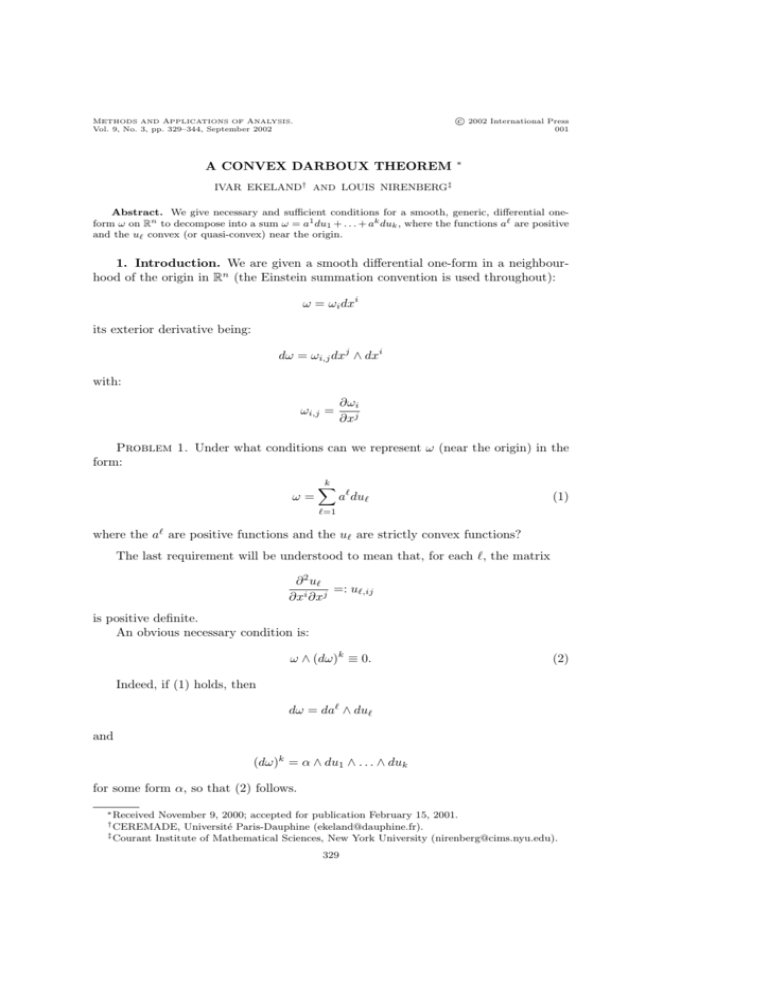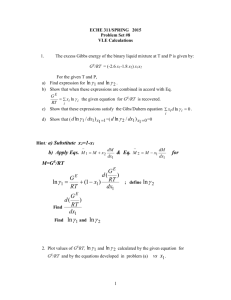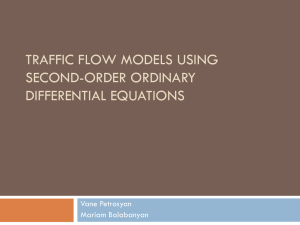A CONVEX DARBOUX THEOREM 1. Introduction
advertisement

c 2002 International Press
METHODS AND APPLICATIONS OF ANALYSIS.
Vol. 9, No. 3, pp. 329–344, September 2002
001
A CONVEX DARBOUX THEOREM
∗
IVAR EKELAND† AND LOUIS NIRENBERG‡
Abstract. We give necessary and sufficient conditions for a smooth, generic, differential oneform ω on Rn to decompose into a sum ω = a1 du1 + . . . + ak duk , where the functions a are positive
and the u convex (or quasi-convex) near the origin.
1. Introduction. We are given a smooth differential one-form in a neighbourhood of the origin in Rn (the Einstein summation convention is used throughout):
ω = ωi dxi
its exterior derivative being:
dω = ωi,j dxj ∧ dxi
with:
∂ωi
∂xj
ωi,j =
Problem 1. Under what conditions can we represent ω (near the origin) in the
form:
ω=
k
a du
(1)
=1
where the a are positive functions and the u are strictly convex functions?
The last requirement will be understood to mean that, for each , the matrix
∂ 2 u
=: u,ij
∂xi ∂xj
is positive definite.
An obvious necessary condition is:
ω ∧ (dω)k ≡ 0.
(2)
Indeed, if (1) holds, then
dω = da ∧ du
and
(dω)k = α ∧ du1 ∧ . . . ∧ duk
for some form α, so that (2) follows.
∗ Received
November 9, 2000; accepted for publication February 15, 2001.
Université Paris-Dauphine (ekeland@dauphine.fr).
‡ Courant Institute of Mathematical Sciences, New York University (nirenberg@cims.nyu.edu).
† CEREMADE,
329
330
I. EKELAND AND L. NIRENBERG
We will always assume the generic condition:
ω ∧ (dω)k−1 = 0.
(3)
Definition 1. We say that a smooth one-form ω satisfies the k-fold Darboux
condition at the origin if (2) holds on some neighbourhood of the origin.
It is a theorem of Darboux (see [2], theorem II.3.3) that, provided (3) holds, this
condition is necessary and sufficient for the representation (1) near the origin, if we
do not require the positivity of the a nor the convexity of the u .
In [3], Chiappori and Ekeland asked what further conditions are needed to have
this representation with the a positive and the u convex. They treated the case
when ω is real analytic by using Cartan-Kähler theory, and they found the following
to be necessary and sufficient:
Condition 1. There is some neighbourhood of the origin where the matrix with
coefficients ωi,j is the sum of two matrices, a positive definite one and another one of
rank k.
Shortly afterwards, V.M. Zakalyukin studied the nonanalytic case, when ω is
merely smooth. He found a necessary and sufficient condition, theorem 1 of [5],
which, surprisingly, is slightly different. He introduces the space A2 (ω) of all tangent
vector fields ξ such that:
ω | ξ = 0
dω, (ξ, η) = 0 ∀η,
and in addition to condition 1, he requires the following:
Condition 2. There is some neighbourhood of the origin where the matrix ωi,j +
ωj,i is positive definite on A2 (ω).
The present paper began as an attempt to understand the proof in [5]. We began
by investigating the low-dimensional case, and to our surprise we found counterexamples to the preceeding results, both [3] and [5]. We present two, with k = 2, that is,
we are trying to write
ω = a1 du1 + a2 du2 .
(4)
Example 1. Here n = 4, the Darboux condition holds and condition 1 as well.
Set:
ω = (1 + x1 + x4 )dx1 + x2 dx2 + (x3 + x2 )dx3 .
Then
dω = dx4 ∧ dx1 + dx2 ∧ dx3
and clearly (3) holds, as well
⎛
1
⎜0
ωi,j = ⎜
⎝0
0
as the Darboux condition.
⎞
⎛
0 0 1
0 0
⎜0 0
1 0 0⎟
⎟ = Id + ⎜
⎝0 1
1 1 0⎠
0 0 0
0 0
Further, we have:
⎞
0 1
0 0⎟
⎟.
0 0⎠
0 −1
331
A CONVEX DARBOUX THEOREM
The last matrix has rank 2, so condition 1 holds. However, the problem has no
solution. Indeed, if relation (4) holds, then u1 satisfies:
du1 ∧ ω ∧ dω = du1 ∧ a2 du2 ∧ dω ≡ 0
(5)
On the other hand:
ω ∧ dω = (1 + x1 + x4 )dx1 ∧ dx2 ∧ dx3 .
Substituting into (5) yields
(1 + x1 + x4 )u1,4 ≡ 0.
So u1,4 ≡ 0 and u1 cannot be strictly convex.
Example 2. Here n = 5, the Darboux condition holds, and conditions 1 and 2
as well. Set:
ω = −x2 dx1 + x1 dx2 + (1 + x3 )dx3 + (1 + x4 )dx4 + (1 + x5 )dx5 .
(6)
Then
dω = 2dx1 ∧ dx2
ω ∧ dω = 2dx1 ∧ dx2 (1 + x3 )dx3 + (1 + x4 )dx4 + (1 + x5 )dx5 .
so that (3) holds, as well as the
⎛
0 −1 0
⎜1 0 0
⎜
ωi,j = ⎜
⎜0 0 1
⎝0 0 0
0 0 0
Darboux condition. We also have:
⎛
⎞
−1 −1 0 0
0 0
⎜ 1 −1 0 0
0 0⎟
⎜
⎟
⎜
0 0 0
0 0⎟
⎟ = Id + ⎜ 0
⎝0
⎠
0 0 0
1 0
0
0 0 0
0 1
⎞
0
0⎟
⎟
0⎟
⎟.
0⎠
0
(7)
so condition 1 holds as well. Finally, at the origin, ξ belonging to A2 (ω) means that
ξ3 + ξ4 + ξ5 = 0
2(ξ 1 η 2 − ξ 2 η 1 ) = 0 ∀(η 1 , η 2 )
the latter equation meaning that ξ 1 = ξ 2 = 0. We see that the matrix ωi,j + ωj,i is
positive definite on vectors of the form (0, 0, ξ 3 , ξ 4 , ξ 5 ). So the condition 2 is satisfied
also. However, in Appendix A, we present a proof that for the one-form ω given by
(6) the problem has no solution.
In this paper, we find the necessary and sufficient conditions, always assuming
(3), that a smooth ω must satisfy for the problem to have a solution.
First, we introduce in the space of all one-forms α a subset I defined as follows:
(8)
I = α | α ∧ ω ∧ (dω)k−1 ≡ 0
Condition 3. There is a k-dimensional subspace V of I(0), containing ω(0),
and such that on N = V ⊥ , the matrix ωi,j (0) is symmetric and positive definite.
332
I. EKELAND AND L. NIRENBERG
In their seminal paper, [1], Browning and Chiappori investigated the consumption behaviour of a two-person household spending jointly one unit of account. This
amounts to a particular case of problem 1, with k = 2 and:
ωj (x)xj = 1.
Browning and Chiappori then consider the matrix S = (sij ) defined by:
sij = ωi,j + xk ωi,k ωj ,
and they show that S = Σ + A, where Σ is a symmetric matrix, positive semi-definite,
and A = (aij ) has rank at most one.
Suppose
definite and A has rank exactly one: aij = ui vj ,
Σ is in fact positive
vi dxi are both non-zero. A simple computation shows
where α = ui dxi and β =
that:
ω ∧ dω = −ω ∧ α ∧ β
so that α and β belong to I. One then checks that S coincides with Σ on the
orthogonal of the two-dimensional subspace spanned by ω and α, so the BrowningChiappori condition amounts to condition 3 in that particular case.
Theorem 1. Assume ω is a smooth one-form satisfying (3). Problem 1 has a
solution if and only if the k-fold Darboux condition is satisfied near the origin, and
condition 3 is satisfied at the origin.
Let us rewrite condition 3 at the origin. Define N as the subspace of vectors ξ,
tangent at the origin, such that:
ξ | α = 0 ∀α ∈ V.
Condition 3 requires that:
ωi,j (0)ξ i η j = ωi,j (0)η i ξ j ∀ξ, η ∈ N,
ωi,j (0)ξ i ξ j > 0 ∀0 = ξ ∈ N.
Note that condition 3 by itself is not open (if it holds at some point, it need not
hold in a neigbourhood). Theorem 1 implies that it becomes open if we impose in
addition the Darboux condition.
Proof of necessity. Assume problem (1) has a solution. We already know that
the Darboux condition has to hold. At the origin (and hence nearby) the dui are
linearly independent; for otherwise, we could express ω(0) as a linear combination of
k−1 of them, and it would then follow that ω∧(dω)k−1 = 0 at the origin, contradicting
(3).
Note next, as we did in example 1 for the case k = 2, that relation (1) implies:
ω ∧ (dω)k−1 = Θ ∧ du1 ∧ . . . ∧ duk
for some (k − 1)-form Θ, so that
dui ∧ ω ∧ (dω)k−1 = 0.
A CONVEX DARBOUX THEOREM
333
Thus dui lies in I for all i. Let V be the k-dimensional subspace spanned by
du1 , . . . , duk . By (1), the linear form ω(0) lies in V . Set N = V ⊥ and take ξ and η in
N . Differentiating (1), we find:
ωi,j = aj u,i + a u,ij .
(9)
Writing u,i ξ i = u,i η i = 0 in the preceding equation , we get:
ωi,j ξ i η j = a u,ij ξ i η j
The right-hand side is symmetric in ξ and η, and so therefore is the left. Furthermore, taking ξ = η, we see that ωi,j is positive definite, as announced. Necessity is
proved.
To conclude this section, let us state (and solve) a related problem. Recall first
that a function u is quasi-convex iff the level sets {x | u(x) ≤ h} are convex for every
h, and strictly quasi-convex if these level sets are stricly convex. A second-order
necessary and sufficient condition for quasi-convexity is that the restriction of the
quadratic form uij ξ i ξ j to the subspace ui ξ i = 0 be positive semidefinite (see [4],
theorem M.C.4). If it is positive definite, the function is strictly quasi-convex.
Such functions play an important role in economics, since direct utility functions
are typically quasi-concave, and the indirect utility functions quasi-convex (see [4],
proposition 3.D.3). In this context, the following is a natural question:
Problem 2. Under what conditions can we represent ω (near the origin) in the
form:
ω=
k
a du
(10)
=1
where the a are positive functions and the u are strictly quasi-convex functions?
Clearly, (strictly) convex functions are (strictly) quasi-convex, so any solution to
problem 1 is a solution to problem 2. So problem 2 would seem to be more general
than problem 1. This is not the case: the problems are equivalent. This follows from
Lemma 1. Assume that the function u is strictly quasi-convex at the origin, in the
sense that the restriction of the quadratic form uij (0)ξ i ξ j to the subspace ui (0)ξ i = 0
is positive definite. Then there is an increasing function φ(t), defined on a small
interval containing u(0), such that φ ◦ u is strictly convex at the origin, in the sense
that the quadratic form (φ ◦ u)ij (0)ξ i ξ j is positive definite.
Proof. We may assume u(0) = 0 and du(0) = dx1 . Take φ (0) = 1 and φ (0) = K
We have:
(φ ◦ u)ij (0)ξ i ξ j = uij (0)ξ i ξ j + K(ξ 1 )2
which can be made positive definite by choosing K large enough.
So any decomposition
ω=
k
a du
=1
in terms of functions u strictly quasi-convex at the origin (and hence strictly quasiconvex near the origin) yields a similar decomposition in terms of strictly convex
334
I. EKELAND AND L. NIRENBERG
functions. Indeed, choose for each u a function φ such that φ (u ) = 1 at the origin
and v = φ ◦ u is strictly convex. Then:
ω=
k
a
dv
φ (u )
=1 and the coefficients are clearly positive. So theorem 1 provides an answer both to
problems 1 and 2.
2. Preliminaries. The following algebraic result will be used repeatedly. It is
proposition I.1.6. of [2].
Lemma 2. Let α1 , . . . , αp+1 be linearly independent one-forms and Ω a two-form
such that:
α1 ∧ . . . ∧ αp ∧ Ωq = 0
for some positive integers p and q. Then
α1 ∧ . . . ∧ αp−1 ∧ Ωq+1 = 0
From now on we assume that ω satisfies the conditions of theorem 1.
There are (n−1) one-forms α1 , . . . , αn−1 , which, together with ω, span all 1-forms.
We write:
dω = ω ∧ β + Ω
(11)
where Ω is a two-form involving the αi only. Then, for any ,
ω ∧ (dω) = ω ∧ (ω ∧ β ∧ Ω−1 + Ω ) = ω ∧ Ω .
(12)
Thus, setting = k − 1 and k in succession, we find that:
Ωk−1 = 0,
Ωk ≡ 0.
By another algebraic result, namely theorem I.1.7 in [2], there exist 2k −2 linearly
, in the span of the αi , and such
independent one-forms, σ1 , . . . , σk−1 , σ1 , . . . , σk−1
that:
Ω=
k−1
σ ∧ σ
(13)
=1
Inserting this in relation (11), we finally get
dω = ω ∧ β +
k−1
σ ∧ σ
(14)
=1
One last algebraic result will be needed.
Lemma 3. Let α1 , . . . , α−1 be one-forms such that α1 , . . . , α−1 , ω are linearly
independent and satisfy:
α1 ∧ . . . ∧ α−1 ∧ ω ∧ (dω)k−+1 ≡ 0.
A CONVEX DARBOUX THEOREM
335
Define J to be the set of one-forms α such that:
α ∧ α1 ∧ . . . ∧ α−1 ∧ ω ∧ (dω)k− ≡ 0.
Then:
(i) J is spanned by 2k − one-forms τ1 , . . . , τ2k−
(ii) If Θ is a two-form satisfying
Θ ∧ α1 ∧ . . . ∧ α−1 ∧ ω ∧ (dω)k− ≡ 0.
then there exist one-forms µi such that
Θ=
2k−
µi ∧ τi
i=1
The proof is deferred to Appendix B.
We are going to construct the functions u1 , . . . ., uk by the successive equations:
du1 ∧ ω ∧ (dω)k−1 ≡ 0, ie du1 ∈ I
(15.1)
du2 ∧ du1 ∧ ω ∧ (dω)k−2 ≡ 0,
(15.2)
du ∧ . . . ∧ du1 ∧ ω ∧ (dω)k− ≡ 0,
(15.)
duk−1 ∧ duk−2 ∧ . . . ∧ du1 ∧ ω ∧ dω ≡ 0,
duk ∧ . . . ∧ du1 ∧ ω ≡ 0.
(15.k − 1)
(15.k)
At the origin the du are to be linearly independent and to lie in V . Furthermore,
each u will be strictly convex, the a will be positive, and there will be conditions on
the du (0). We will do this inductively on .
Observe first that the set I of one-forms, defined by (8), is a linear space of
dimension (2k − 1) . Indeed, using (12) and (13), we find that α belongs to I if and
only if:
0 ≡ α ∧ ω ∧ Ωk−1
≡ cα ∧ ω ∧ σ1 ∧ σ1 . . . ∧ σk−1 ∧ σk−1
for some c = 0. This means that
.
I = Span ω, σ1 , σ1 , . . . , σk−1 , σk−1
336
I. EKELAND AND L. NIRENBERG
We claim that I generates a differential ideal. This is equivalent to the Frobenius
condition: if α1 , . . . , α2k−1 span I, then there are one-forms µij such that, for 1 ≤
i ≤ 2k − 1:
dαi =
2k−1
µij ∧ αj .
(16)
i=1
To verify (16), we take α in I and apply d to (8):
dα ∧ ω ∧ (dω)k−1 = α ∧ (dω)k
which vanishes by lemma 2. Relation (16) then follows by lemma 3 (ii)
Assume u1 , . . . , u−1 have been obtained, satisfying equations (15.1) to (15. − 1),
with ω and the differentials dui linearly independent.We then define a set I of oneforms α by:
I = α | α ∧ du−1 ∧ . . . ∧ du1 ∧ ω ∧ (dω)k− ≡ 0
It follows from lemma 2 that:
I ⊂ I−1 ⊂ . . . ⊂ I1
(17)
and the assumption on the ui , 1 ≤ i ≤ , means that:
ui ∈ Ii ∀i ≤ (18)
For = 1, we get I1 = I.
For = k, we get:
Ik = {α | α ∧ duk−1 ∧ . . . ∧ du1 ∧ ω ≡ 0}
= Span {ω, du1 , . . . , duk−1 }
which is a k-dimensional linear space.
We claim that Ik generates a differential ideal. Indeed, if α ∈ Ik , we apply d to
the system for α, and we get:
dα ∧ duk−1 ∧ . . . ∧ du1 ∧ ω ≡ ±α ∧ duk−1 ∧ . . . ∧ du1 ∧ dω
≡0
because α is a linear combination of ω, du1 , . . . , duk−1 , and uk−1 has been assumed
to satify equation (15.k − 1). As above, using lemma 3 (ii), we find that the forms
ω, du1 , . . . , duk−1 satisfy the Frobenius condition, so that Ik generates a differential
ideal.
For 1 < < k, by lemma 3 (i), I is at each point a linear space of dimension
2k − . We claim that I generates a differential ideal. For, if α ∈ I , then, applying
d to the system defining α, we obtain:
dα ∧ du−1 ∧ . . . ∧ du1 ∧ ω ∧ (dω)k− ≡ ±α ∧ du−1 ∧ . . . ∧ du1 ∧ (dω)k−+1
and the right-hand side vanishes by lemma 2. Using lemma 3 (ii) we conclude that I
is spanned by one-forms satisfying the Frobenius condition, so that it is a differential
ideal.
A CONVEX DARBOUX THEOREM
337
3. Proof of sufficiency. Without loss of generality, we may suppose that at
the origin ω = dx1 , and that V is spanned by dx1 , . . . , dxk . Thus N consists of all
vectors ξ, tangent at the origin, such that:
ξ 1 = . . . = ξ k = 0.
and the assumed symmetry of ωi,j (0) on N means simply that:
ωi,j (0) = ωj,i (0) ∀i, j > k.
Thus:
dω(0) = dx1 ∧ β1 + τ with τ = dx2 ∧ β2 + . . . + dxk ∧ βk
where each βi involves only the dxj with j > i. And so at the origin:
ω ∧ (dω)k− = ω ∧ (τ )k− , with τ k = 0.
We will need:
Lemma 4. At the origin, if α1 , . . . , α are any linear forms in V , then:
α1 ∧ . . . ∧ α ∧ ω ∧ (dω)k− = 0.
Proof. Write, for i = 1, . . . , :
αi =
k
αij dxj = αi1 dx1 + αi .
j=1
Then:
α1 ∧ . . . ∧ α ∧ ω ∧ (dω)k− = α1 ∧ . . . ∧ α ∧ ω ∧ (dω)k−
= α1 ∧ . . . ∧ α ∧ ω ∧ (τ )k− ,
and the right-hand side vanishes for every term involves k products of the (k − 1)
one-forms dx2 , . . . , dxk .
3.1. Construction of u1 . Since I has dimension 2k − 1 and satisfies (16), it
follows from the Frobenius theorem (see [2], theorem II.1.1) that there exists 2k − 1
functions v1 , . . . , v2k−1 , the differentials of which span I. We may choose v1 , . . . , vk
such that, at the origin:
dvi (0) = dxi , f or i = 1, . . . , k
vj (0) = 0 ∀j.
Since ω belongs to I, we may write:
ω=
2k−1
f dv ,
=1
with f 1 (0) = 1 and f (0) = 0 for > 1. So:
ωi = f v,i
ωi,j (0) = v1,ij (0) + fj (0)v,i (0).
338
I. EKELAND AND L. NIRENBERG
Now use the fact that ωi,j (0) is positive definite on N , and hence on I ⊥ (0), which
is a smaller space. For ξ ∈ I ⊥ (0), we have:
v,i (0)ξ i = 0 = 1, . . . , 2k − 1
(19)
cξ2 ≤ ωi,j (0)ξ i ξ j = v1,ij (0)ξ i ξ j , c > 0.
(20)
and:
Set
u1 = v1 + 1 v2 + K
2k−1
(v )2
(21)
1
for 1 > 0 small and K large. Then u1 is a solution of (15.1), that is, du1 ∈ I. We
claim that u1 is strictly convex at the origin. Indeed, at the origin:
u1,ij (0)ξ i ξ j = v1,ij (0)ξ i ξ j + 1 v2,ij (0)ξ i ξ j + 2K
(v,i (0)ξ i )2 .
Thus, for ξ ∈ I ⊥ (0), we have, according to (19) and (20):
u1,ij (0)ξ i ξ j = ωi,j (0)ξ i ξ j + 1 v2,ij (0)ξ i ξ j
≥ c/2ξ2 for 1 small
When ξ belongs to a complementary subspace of I ⊥ (0), the last term in (21)
takes precedence, so that, for K large enough:
u1,ij (0)ξ i ξ j ≥
c
ξ2 , c > 0.
2
for all vectors ξ tangent at the origin. This finishes the construction of u1 . Note that:
du1 (0) = dx1 + 1 dx2
(22)
3.2. Construction of the u , for ≤ k − 1. We now argue by induction.
Suppose we have constructed functions:
u1 , . . . , u−1 ,
for ≤ k − 1, and positive numbers
1 , . . . , −1
satisfying recursively (15.1), . . . , (15. − 1), the matrix ui,rs (0) being positive definite,
and
dui (0) = dx1 − i dxi + i dxi+1
(23)
for 2 ≤ i ≤ − 1, while (22) holds for i = 1. We now construct u with similar
properties.
Since I generates a differential ideal, and has dimension 2k − , using Frobenius
again we find that there exist 2k − functions v1 , . . . , v2k− spanning I .
A CONVEX DARBOUX THEOREM
339
Because of (22) and (23), the dui (0), 1 ≤ i ≤ − 1, all belong to V . Comparing
lemma 4 with the definition of I , we find that V ⊂ I (0), so that we may assume
that:
dvi (0) = dxi f or i = 1, . . . , k.
Again, we may represent:
ωi = f v,i ,
using functions f with f 1 (0) = 1 and f (0) = 0 for > 1. Thus, at the origin:
ωi,j (0) = v1,ij + fj v,i
Since I (0) ⊃ V , we have I (0)⊥ ⊂ N . For ξ ∈ I (0)⊥ , we get:
ωi,j (0)ξ i ξ j = v1,ij (0)ξ i ξ j
By our assumption on V , it follows that, for some c > 0, we have:
v1,ij (0)ξ i ξ j ≥ cξ2 , ∀ξ ∈ I (0)⊥
We now define:
u = v1 − v + v+1 + K
2k−
v2
s=1
Just as before, we find that
u,ij (0)ξ i ξ j ≥
c
ξ2 ,
2
provided is small and K large. We have u ∈ I , and at the origin:
du (0) = dx1 − dx + dx+1
3.3. Construction of uk and conclusion. We have thus constructed
u1 , . . . , uk−1 with the desired properties, and we finally construct uk . Again, Ik has
dimension k and generates a differential ideal, so that it is spanned by the differentials
of k functions w1 , . . . , wk . As above, Ik (0) = V , so we may choose
dwi (0) = dxi (0), i = 1, . . . , k
We now set:
uk = w1 − k wk + K
k
w2
1
As before, using the fact that ωi,j (0) is positive definite on N = V ⊥ , we find that
for k small and K large, we have
uk,ij (0)ξ i ξ j ≥
c
ξ2
2
340
I. EKELAND AND L. NIRENBERG
while:
duk (0) = dx1 − k dxk
To complete the proof of the theorem, we must show that in the representation
ω=
k
a du
=1
all the a are positive at the origin. Well, at the origin, the dui (0) are independent,
so the a (0) are unique. But at the origin;
ω(0) = dx1
du1 (0) = dx1 + 1 dx2
du2 (0) = dx1 − 2 dx2 + 2 dx3
...
duk−1 (0) = dx1 − k−1 dxk−1 + k−1 dxk
duk (0) = dx1 − k dxk .
Then:
1
1
du1 (0) = dx1 + dx2
1
1
1
1
du2 (0) = dx1 − dx2 + dx3
2
2
...
1
1
duk−1 (0) =
dx1 − dxk−1 + dxk
k−1
k−1
1
1
duk (0) = dx1 − dxk .
k
k
Summing up, we get:
1
1
dui (0) = (
)dx1
i
i
i
i
which gives the desired decomposition ω(0) = a (0)du (0), with
(1/i )]−1 > 0
a (0) = [
.
This concludes the proof.
Appendix A. Proof of Example 2. We prove that for the one-form ω given
by (6) the problem has no solution. Assume otherwise; for the sake of convenience,
write u1 = u, u2 = v, a1 = a, and a2 = b, so that
ω = adu + bdv
In particular, on the plane x3 = x4 = x5 = 0, we have:
au1 + bv1 = −x2
1
au2 + bv2 = x .
(24)
(25)
341
A CONVEX DARBOUX THEOREM
We may assume u(0) = v(0) = 0. Expanding u and v near the origin in the plane
(x1 , x2 ), we have:
u = c1 x1 + c2 x2 + Q1 (x1 , x2 ) + o(x2 )
v = d1 x1 + d2 x2 + Q2 (x1 , x2 ) + o(x2 )
where Q1 and Q2 are positive definite quadratic forms.
From (24) and (25), we have:
a(u2 v1 − u1 v2 ) = x1 v1 + x2 v2 = d1 x1 + d2 x2 + 2Q2 (x1 , x2 ) + o(x2 )
1
2
1
2
1
2
2
b(u1 v2 − u2 v1 ) = x u1 + x u2 = c1 x + c2 x + 2Q1 (x , x ) + o(x ).
(26)
(27)
At the origin, the right-hand sides vanish , and since a and b are positive, we must
have u2 v1 − u1 v2 = 0. This implies that the vectors (c1 , c2 ) and (d1 , d2 ) are parallel.
One or both may vanish, but in any case we can choose (x1 , x2 ) = 0 near the origin
so that
c1 x1 + c2 x2 = 0 = d1 x1 + d2 x2 .
For such a choice of (x1 , x2 ), the right-hand sides of (26) and (27) are positive.
But the left-hand sides have opposite signs. This is a contradiction.
Appendix B. Proof of lemma 3. We begin by an algebraic result:
Lemma 5. Consider a 2m-dimensional space of one-forms spanned by
σ1 , σ1 , . . . , σm , σm
,
and set:
Ω = σ1 ∧ σ1 + . . . + σm ∧ σm
so that Ωm = 0. Let γ1 , . . . γs−1 be linearly independent one-forms such that:
γ1 ∧ . . . ∧ γs−1 ∧ Ωm−s+2 ≡ 0.
Then :
(i) There is a set of one-forms β1 , . . . , βm , γs , . . . , γm
such that:
Ω=
s−1
γi ∧ βi +
i=1
m
γj ∧ βj .
(28)
j=s
(ii) The space of one-forms
Ms = α | α ∧ γ1 ∧ . . . ∧ γs−1 ∧ Ωm−s+1 ≡ 0
is spanned by the γi , γj , β , for 1 ≤ i < s ≤ j ≤ m, 1 ≤ ≤ m, and so has
dimension 2m − s + 1.
Proof. We first assume (i) to prove (ii).
If (28) holds, since Ωm = 0, the βi , γi and γi must be linearly independent. The
system defining Js then becomes:
m
m−s+1
γi ∧ βi
0 = α ∧ γ1 ∧ . . . ∧ γs−1 ∧
i=s
= (m − s + 1)! α ∧ γ1 ∧ . . . ∧ γs−1 ∧ γs ∧ βs ∧ . . . ∧ γm
∧ βm
342
I. EKELAND AND L. NIRENBERG
We end up with:
Ms = Span γi , γj , βj | 1 ≤ i ≤ s − 1, s ≤ j ≤ m
so that (ii) is proved.
Now to prove (i). This will be done by induction on s. For s = 1, we can take
βi = σi and γi = σi , so the lemma holds in this case.
Suppose (i) holds up to s = r; we wish to establish it for s = r + 1. Let γ1 , . . . , γr
be linearly independent one-forms satisfying
γ1 ∧ . . . ∧ γr ∧ Ωm−r+1 ≡ 0.
This means that γr belongs to Mr . Since (28) holds for s = r, we have seen that
γr then belongs to the linear span of the γi , γj , βj , for 1 ≤ i < r ≤ j ≤ m:
γr =
r−1
ci γi +
i=1
m
bj βj +
j=r
m
aj γj
j=r
At least one of the bj or aj must be non-zero. Suppose it is ar ; the case where all
the aj vanish and br = 0 would be treated in the same way. We may assume ar = 1.
Then:
r−1
γr = γr −
ci γi −
i=1
m
m
bj βj −
j=r
aj γj
(29)
j=r+1
Because (28) holds up for s = r, we have:
Ω=
r−1
γi ∧ βi +
i=1
m
γj ∧ βj .
j=r
Replacing γr in this expression by its value, taken from (29), we obtain:
Ω=
r−1
γi ∧ (βi − ci βr ) + γr ∧ βr +
i=1
m
(γi + bj βr ) ∧ (βj − aj βr )
j=r+1
Setting:
β i = βi − ci βr f or 1 ≤ i ≤ r − 1
β r = βr
γ j = γj + bj βr f or r + 1 ≤ j ≤ m
β j = βj − aj βr f or r + 1 ≤ j ≤ m,
we rewrite (30) as follows:
Ω=
r
i=1
γi ∧ β i +
m
γ j ∧ β j
j=r+1
so (28) holds for s = r + 1, and the lemma is proved.
(30)
A CONVEX DARBOUX THEOREM
Proof of lemma 3(i). We show first that:
J = α | α ∧ α−1 ∧ . . . ∧ α1 ∧ ω ∧ (dω)k− ≡ 0 ,
343
(31)
has dimension 2k − .
Recall that the α1 , . . . , α−1 and ω are linearly independent, and satisfy
α1 ∧ . . . ∧ α ∧ ω ∧ (dω)k−+1 ≡ 0.
(32)
By lemma 2 , J and the αi belong to I, and so is αi is a linear combination of
ω and the σj , σj . Thus we may write:
αi = bi ω + γi f or 1 ≤ i ≤ − 1
(33)
where γi is a linear combination of the σj , σj . Inserting (33) in (32), we obtain:
γ1 ∧ . . . ∧ γ−1 ∧ ω ∧ (dω)k−+1 ≡ 0.
(34)
.
On the other hand, by relation (14), we have:
dω = ω ∧ β + Ω,
with Ω =
k−1
σ ∧ σ
i=1
so equation (34) becomes:
γ1 ∧ . . . ∧ γ−1 ∧ ω ∧ Ωk−+1 ≡ 0.
(35)
γ−1 ∧ . . . ∧ γ1 ∧ Ωk−+1 ≡ 0
(36)
This implies:
Indeed, the left-hand side is a k-form involving only the σj , σj , and if it did not
vanish, taking the wedge product with ω, which is linearly independent from the σj , σj
would contradict (35).
Consider any α in J . We may write α = bω + α̂, where α̂ is a linear combination
of the σi , σi , and equation (31) implies:
α̂ ∧ γ1 ∧ . . . ∧ γ−1 ∧ Ωk− = 0
By lemma 5, with m = k−1, we see that the set of such α̂ has dimension 2k−−1,
so J , which is spanned by these α̂ and by ω, has dimension 2k − .
Proof of lemma 3(ii). Suppose the two-form Θ satisfies the prescribed condition. Then:
Θ ∧ α1 ∧ . . . ∧ α−1 ∧ ω ∧ Ωk− ≡ 0.
Using (33), we get:
Θ ∧ γ1 ∧ . . . ∧ γ−1 ∧ ω ∧ Ωk− ≡ 0.
and the γ1 , . . . , γ−1 satisfy (36)
344
I. EKELAND AND L. NIRENBERG
k − 1,
By lemma 5 (i), with m =
such that:
β1 , . . . , βk−1 , γ , . . . , γk−1
Ω=
−1
γi ∧ βi +
i=1
k−1
there is a set of one-forms
γj ∧ βj ,
j=
and hence:
Θ ∧ γ1 ∧ . . . ∧ γ−1 ∧ ω ∧ γ ∧ β ∧ . . . ∧ γk−1
∧ βk−1 ≡ 0.
Set τ1 = ω, τ2 = γ1 , τ = γ−1 , τ+1 = γ , . . . , . . . , τk = γk−1
, τk+1 = β , . . . ,
τ2k− = βk−1 . By lemma 5 (ii), they are all independent and span J . Then the
preceding equation takes the form:
Θ ∧ τ1 ∧ . . . ∧ τ2k− ≡ 0.
(37)
The τi , together with n − (2k − ) forms τ2k−+1
, . . . , τn , span all one-forms. We
may therefore write:
Θ=
2k−
µi ∧ τi +
i=1
n
f ij τi ∧ τj .
(38)
2k−<i<j
It then follows from (37) that:
τ1 ∧ . . . ∧ τ2k− ∧
n
f ij τi ∧ τj . ≡ 0
2k−<i<j
which means that the f ij all are identically zero. Equation (38) then has the desired
form.
REFERENCES
[1] M. Browning and P.A. Chiappori, Efficient intra-household allocations: a general characterization and empirical tests, Econometrica, 66 (1998), pp. 1241–1278.
[2] R. Bryant, S. Chern, R. Gardner, H. Goldschmidt, P. Griffiths, Exterior Differential
Systems, Springer-Verlag, 1991.
[3] P.A. Chiappori and I. Ekeland, A convex Darboux theorem, Annali della Scuola Normale di
Pisa, Cl. Sci (4), XXV (1997), pp. 287–297.
[4] A. Mas-Colell, M. Whinston, J. Green, Microeconomic theory, Oxford University Press,
1995.
[5] V. Zakalyukin, Concave Darboux theorem, CRAS Paris 327, série 1, (1998), pp.633–638.







